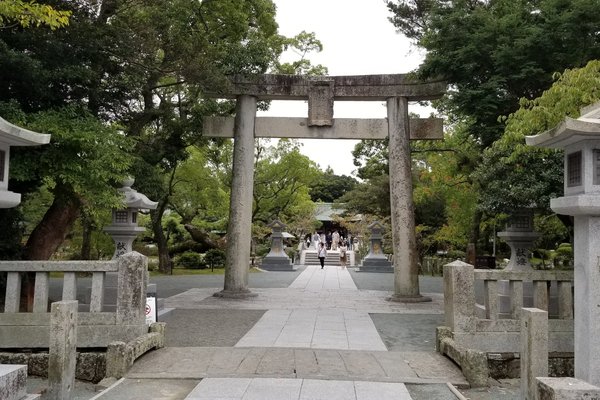Japan
Okinoshima Island
The Sacred Island of Okinoshima and Associated Sites in the Munakata Region is an early ritual site associated with maritime safety.
From the 4th century, votive offerings were made here to pray for the safety of boats heading to Korea and China to trade. There are several taboos and restrictions on visiting Okinoshima, including a ban on women and the prohibition “to speak of anything they have seen or heard on the Island”. The site includes three nearby islets, Koyajima, Mikadobashira and Tenguiwa, and four living places of worship on Kyushu.
Community Perspective: As the entrance to Okinoshima Island is almost fully barred, the reviewers focused on the associated mainland temples. Hetsu-miya Shrine near Fukuoka is the easiest to visit: Thomas provides information on public transport, Frederik details what's to see, and Els warns not to overlook anything. AC covered two additional locations and saw Okinoshima Island from a distance.
Site Info
Official Information
- Full Name
- Sacred Island of Okinoshima and Associated Sites in the Munakata Region (ID: 1535)
- Country
- Japan
- Status
-
Inscribed 2017
Site history
History of Okinoshima Island
- 2017: Inscribed
- Inscribed
- Type
- Cultural
- Criteria
- ii
- iii
Links
- UNESCO
- whc.unesco.org
- Official
-
- okinoshima-heritage.jp — Okinoshima heritage
All Links
UNESCO.org
- whc.unesco.org — whc.unesco.org/
Official Website
- okinoshima-heritage.jp — Okinoshima heritage
News Article
- July 16, 2017 firstpost.com — Japan's men-only world heritage island Okinoshima will have no visitors next year
Community Information
- Community Category
- Religious structure: Indigenous
Travel Information
Discriminatory Entry Policies
Kagoshima Hotspot
Hiroshima Hotspot
Recent Connections
-
Discriminatory Entry Policies
No women allowed on Okinoshima Island -
Kagoshima Hotspot
Hetsu-miya component is roughly 2.5 hou… -
Hiroshima Hotspot
the main shrine on Kyushu Island is eas…
Connections of Okinoshima Island
- Geography
-
-
Sea of Japan
Okinoshima and the other islets are located in the Sea of Japan
-
- Trivia
-
-
Cultural sites taking up an entire island
Okinoshima Island is fully included (except for the landing pier) -
Dubbed as another WHS
Okinoshima has the nickname Shosoin of the Sea, Shosoin is part of Nara WHS ( the treasure house that belongs to Tōdai-ji in Nara)
-
- History
-
-
Silk Roads
Maritime Route; "shards of Persian glass presumably brought to Japan by way of the distant Silk Road are important pieces of evidence"
-
- Ecology
-
-
Coral
coral reef at 3 islets around Okinoshima, Koyajima, Mikanobashira and Tenguiwa
-
- Architecture
-
-
Japanese garden
Hetsugu Shrine has Japanese garden surrounding its two sacred ponds. -
Wooden architecture
Wooden shrines
-
- World Heritage Process
-
-
Perfect Inscriptions
2017
-
- Religion and Belief
-
-
Legends and Folk Myths
"In the 1600s, a Christian feudal lord, Kuroda Nagamasa, collected the offerings and put them in a tower of his castle. According to legend, the tower began to shake, bright objects streaked through the sky, and diseases plagued Nagamasa's people. Nagamasa returned the objects to the island, and the unsettling events stopped." (wiki)See en.wikipedia.org
-
Shinto
"The entire island is considered a shinto kami" (wiki); all its shrines are Shinto shrines -
Sacred Forests or Groves
"On the northern part of the island is preserved a primeval forest which is revered as a shrine forest." (AB ev) -
Religious sites connected to fishermen
Local fishermen praying at the island shrine for safety and for bumper catches. -
Goddesses
3 Goddesses of Munakata -
Taboo
"A number of taboos abound on Okinoshima: no women are allowed on the Island, all visitors need to purify themselves through a ritual bathing (misogi), absolutely nothing can be taken from the Island, and visitors are prohibited to speak of anything they have seen or heard on the Island; restrictions on food and language also apply." (AB ev)
-
- Human Activity
-
-
Festivals
"Grand Festival and the Miare Festival (a revival of medieval tradition), during which the three goddesses re-join at Hetsu-miya." (AB ev)
-
- Constructions
-
-
Lighthouses
"In 1905 an observation tower and lighthouse were constructed at the top of Mt. Ichinotake on the island" (nom file) -
Tombs
Shimbaru-Nuyama Mounded Tomb Group
-
- Timeline
-
-
Built in the 4th century
early ritual practices associated with maritime safety, which emerged in the 4th century AD (AB ev)
-
- WHS Hotspots
-
-
Kagoshima Hotspot
Hetsu-miya component is roughly 2.5 hours by train via transfer in Fukuoka -
Hiroshima Hotspot
the main shrine on Kyushu Island is easy to visit by bullet train via Kitakyushu and another local train.
-
- Visiting conditions
-
-
Discriminatory Entry Policies
No women allowed on Okinoshima Island
-
News
- firstpost.com 07/16/2017
- Japan's men-only world heritage is…
Recent Visitors
Visitors of Okinoshima Island
- AC
- Alexander Lehmann
- Alex Goh
- Atila Ege
- Carlo Sarion
- chenboada
- Christravelblog
- CugelVance
- Daniel Chazad
- Dimitar Krastev
- Els Slots
- Errol Neo
- Eva Kisgyorgy
- Fan Yibo
- Frederik Dawson
- Hadrianus
- Harry Mitsidis
- henrik_hannfors
- henryjiao18
- Joel on the Road
- Kasper
- Kurt Lauer
- Loic Pedras
- Lukasz Palczewski
- Luke LOU
- Maciej Gil
- Nihal Ege
- Patrik
- Pchxiao
- Peter Lööv
- Petteri
- Randi Thomsen
- ReallyDeepThoughts
- Shandos Cleaver
- SnakeGreen
- Stanislaw Warwas
- Svein Elias
- SymonMajewski
- Taotao Chen
- Tcchang0825
- Thomas Buechler
- usagi1974
- Vincent Cheung
- Xiong Wei
- Xiquinho Silva
- Yongcheng Liu
- Zoë Sheng
Community Reviews
Show full reviews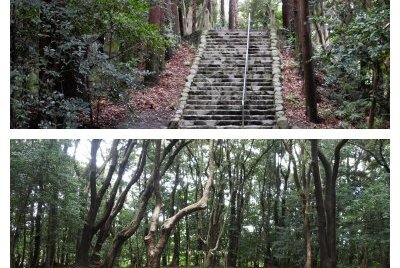
Like most others, I visited the Munakata Taisha a.k.a. Hetsu shrine. I hadn’t planned on writing a review, but I think I have an important tip for future visitors: make sure you see “everything”. The layout of the site is confusing and signage is in Japanese only, so it is easy to overlook something or not do it justice because you don’t know the meaning of what you see.
Right at the entrance you can pick up a flyer (in Japanese of course) with a map that shows the main parts:
- Main wooden worship hall from the 16th century (rebuilt after it burned down). This is the main focus when you enter via the torii and cross the garden with the two ponds.
- Sacred open-air ritual site, one of the few remaining outside of Okinoshima. It is reached via a forest path and several steep flights of stairs from the northeast behind #1. See photos with this review.
- Okitsu and Nakatsu shrines, also known as Shrine Number Two (Teinigu) and Shrine Number Three (Teisangu). They're the newish-looking buildings on a path to the left when you’re on your way to #2. They represent the two eponymous shrines on Okinoshima and Oshima Islands.
- Shinpokan: modern building on the west side of the main complex and near the smaller parking lot. It houses many votive objects found on Okinoshima.
There’s also a “Sea Road City Museum” at the other end of the big parking …
Keep reading 0 comments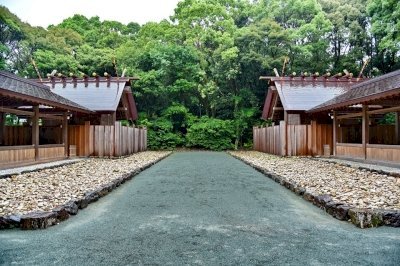
After I visited the World Heritage Site of Okinoshima, to be exact I only visited the mainland part of Munakata Grand Shrine, the Hetsumiya, I really confused what should I be focused on this Japanese site. The original ICOMOS’s recommendation only suggested that only Okinoshima Island should be on the UNESCO list for its outstanding value of archaeology, but when the inscription expanded to include two more shrines, one on the mainland and one on Oshima Island, the raison d'etre of this site for me became obscuring.
When I parked my car on the large carpark area next to the grand modern shrine building of Hetsumiya, I saw a Shinto priest together with few shrine maidens walked around the two front rows of the carpark did a blessing ceremony to provide a divine protection on requested modern cars. I was impressed with this belief since the Goddesses of Munakata originally are the protector of sea travel, signify its role of ancient trade route, then developed to be the protector of every means of transportation especially for cars. Then I walked to the grand shrine, again I impressed with its classic early Shinto shrine layout with straight pathway, Torii gates, small creek, a bridge and ponds of front garden, a rectangular wall forming the inner shrine cloister complex, an early type of shrine layout which has many similarities with ancient temples in China and Korea, a result of cultural exchange via maritime trade route. The inner shine of Hetsumiya was …
Keep reading 0 comments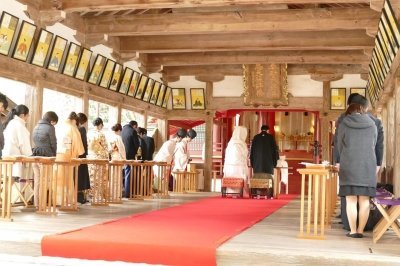
This just deals with the technical side of visiting Hetsu-myia (Munakata Taisha) by public transport from Fukuoka, and combining this visit with the other Unesco site in the region, the Yawata Imperial Steel works in Kitakyushu which is one of the sites of Japan's Meiji Industrial Revolution.
Go to Fukuoka Tenjin station that is very centrally located. Look for bus stop 19, close to the big post office building. If you have difficulties to locate the bus stop ask the people at the Tourist Information office, inside Tenjin station, very helpful staff indeed. Their opening time however is 9.30h. The first bus for the Munakata Taisha temple leaves at 9.00h, followed by two buses at 10.00h and 11.00h, the ride takes 57 minutes, and the bus stop is right in front of the temple. I was lucky to witness the ritual of a traditional wedding where I attach the photo.
At 11.01 there is a return bus to Togo station to connect you with a train of the Kagoshima Line that brings you in 36 minutes to the Space World Station where the Yawata Imperial Steel Factory is located. The train leaves from Togo at 11.18, so not much time left to buy the ticket, but if that connection is missed, there is another one at 11.34h. In fact once you are on the main Kagoshima Line, there is plenty of trains going in both directions. Buses from Munakata to Togo Station however are very limited, for instance between 10.00 …
Keep reading 0 comments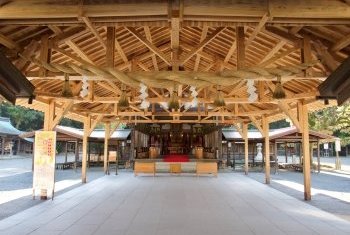
I visited 3 out of the 8 inscribed components of this site on a day trip in early December, namely Hetsu-miya on Kyushu, and Nakatsu-miya and Okitsu-miya Yohaisho both on Oshima. I of course could not visit the main attraction of this site and its attendant islands. As for the tombs I found them to be a hassle to reach and so skipped those.
There are a few direct buses to Hetsu-miya from Fukuoka, and the first one of these on Saturdays (maybe on Sundays too but I did not check on that since I made the visit on a Saturday) goes all the way to the Konominato Port from where the ferry to Oshima can be taken.
Nakatsu-miya has an associated shrine all the way up on the summit of Mt Mitake. Although this is merely a hill a little over 200 m tall, it was still quite a lung-imploding and leg-vein-exploding climb for unfit me. The reward at the top is a little shrine and a lovely view of Kyushu and much of the very green island itself. If the weather is clear, the island of Okinoshima can also be spotted if one knows where to look.
The best place on the island to try to spot Okinoshima however is probably at the back of Okitsu-miya Yohaisho. After all, this shrine was built precisely for people to worship the sacred island without actually having to be there. The shrine therefore appeared to be empty (it was closed but …
Keep reading 0 comments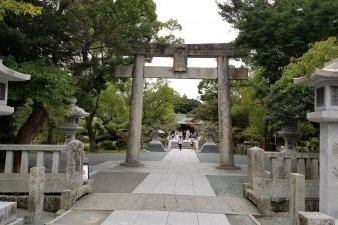
Okinoshima AND RELATED SITES was just recently added to her UNESCO stable. As many already know, going to Okinoshima is not possible for but a few males and even now they are dicussing about making this sacred island visitor-free forever. One needs to understand that these sites were inscribed for cultural reasons and the untouched nature on Okinoshima is impossible to observe.
The other destinations are, however, not difficult to see. Question is if they are worth it though. For the regular Joe tourist there is absolutely nothing special to see. They are Shinto shrines like you see in many places. Have you been to Kyoto? You most likely saw better ones. Unless you are a religious person they don't offer you much value. There are no English signs and all tourist groups are Japanese.
The easiest one to see if just off Fukuoka by taking a half hour train to Togo and then a bus to the Hetsu-miya Shrine (Munakata Taisha actually). The bus will announce this in English. Ensure you know the bus schedule because the couple of buses that go here are very infrequent. If you want to see a bit more then take the bus all the way to the ferry port and take said ferry to Oshima Island. There is another similar Shrine but you also get to see some green island when hiking up the few minutes from the ferry stop.
All in all I don't recommend this trip unless you have a car …
Keep reading 0 comments
